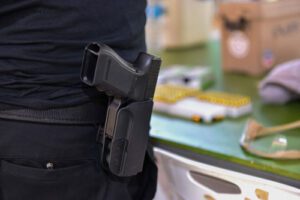 Judge Bumb continued: Defendants do not quarrel with this proposition. Again, Defendants must be able to rebut the presumption that the challenged conduct is constitutionally protected by “demonstrating that the regulation is consistent with this Nation’s historical tradition of firearm regulation.” Bruen, 142 S. Ct. at 2126. To reiterate, Defendants “may not simply posit that the regulation promotes an important interest. Rather, the [Defendants] must demonstrate that the regulation is consistent with this Nation’s historical tradition of firearm regulation.” Id. 13 (emphasis added).
Judge Bumb continued: Defendants do not quarrel with this proposition. Again, Defendants must be able to rebut the presumption that the challenged conduct is constitutionally protected by “demonstrating that the regulation is consistent with this Nation’s historical tradition of firearm regulation.” Bruen, 142 S. Ct. at 2126. To reiterate, Defendants “may not simply posit that the regulation promotes an important interest. Rather, the [Defendants] must demonstrate that the regulation is consistent with this Nation’s historical tradition of firearm regulation.” Id. 13 (emphasis added).
Carefully following this roadmap set forth in Bruen, the Court now considers each of the challenged “sensitive places” set forth in Plaintiffs’ pending motion for emergent injunctive relief. Plaintiffs argue that because the scope of the Second Amendment was set in 1791, that is the key time period for historical tradition analysis as opposed to the prevailing understanding of an individual right when the 14th Amendment was ratified in 1868. [Pls.’ Br. at 19.] Because New Jersey’s lack of support for its newly enacted legislation fails in either time period, whether it be 1791 when the Bill of Rights was enacted or 1868 when the 14th Amendment was, for reasons set forth herein, at this stage the Court need not decide this issue that had been left unresolved in Bruen. See Bruen, 142 S. Ct. at 2163 (“Here, the lack of support for New York’s law in either period makes it unnecessary to choose between them.”) (Barrett, J., concurring).
By stating that Defendants have not met their burden as to presenting historical evidence, the Court does not mean to shift the burden that Plaintiffs have in obtaining injunctive relief. Rather, it is a factor this Court considers as to whether Plaintiffs have met their burden as to the likelihood of success on the merits prong.
In their brief, Defendants have conflated this section of the legislation with “locations for government and constitutionally-protected activity” suggesting a connection with public libraries and museums as “places where the rights to speech and intellectual freedom are at their apex.” [State’s Br. at 29.] This is a stretch to say the least. First, the Second Amendment’s plain text covers the conduct in question (carrying a concealed handgun for self-defense in public). As a result, Defendants must be able to rebut the presumption of protection against this regulation by demonstrating that the regulation is consistent with this Nation’s historical tradition of firearm regulation.
This opinion is complicated in light of the subject matter combined with the injunctive relief standards and rules of civil procedure. Reference to the government in this civil context as “Defendants” further adds to the confusion. The government is typically the plaintiff in cases involving criminal law and firearms issues.
